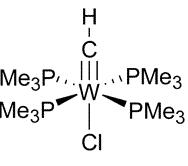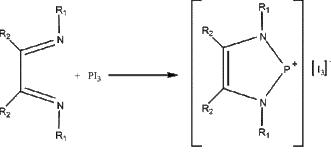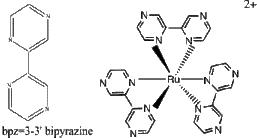Chemistry 401
Intermediate Inorganic Chemistry
University of Rhode Island
Fall 2007
Final Exam
All references are to Inorganic Chemistry, volume 46, 2007.
1. E. F. van der Eide, W. E. Piers, M. Parvez, and R. McDonald (pages 14 – 21) discussed the tungsten(IV) complex shown below. Would you expect this complex to be stable? Explain your reasoning.
2. S. Schneider, M. Gerken, R. Haiges, T. Schroer, J. A. Boatz, D. A. Dixon, D. J. Grant, and K. O. Christe (pages 93 –102) investigated the reactivity of silyldichloramines. Write the Lewis dot structure for (CH3)3SiNCl2, predict the structure about each heavy atom, and estimate all of the bond angles.
3. O. Gourdon, D. Gout, D. J. Williams, T. Proffen, S. Hobbs, and G. J. Miller (pages 251 – 260) did theoretical calculations on brass compositions. The ideal stoichiometry is Cu5Zn8. In this ideal situation, predict which atom will form the lattice and which holes the other atom will occupy. Explain your reasoning.
4. H. Bolvin (pages 417 – 427) studied the Creutz-Taube ion, [(NH3)5Ru-pyrazine-Ru(NH3)5]5+ (pyrazine is shown below). Estimate the LFSE for each Ru ion and determine the spin only magnetic moment.
5. W. Carrier, C. S. Jamieson, and R. I. Kaiser (pages 1332 – 1336) investigated trifluoromethyl sulfur pentafluoride, which is a greenhouse gas. Determine the point group of this molecule.
6. G. Reeske and A. H. Cowley (pages 1426 – 1430) studied the redox reaction shown below. Which species is oxidized and which is reduced? What about the product is unusual, hence interesting?
7. Z. Liu, Q.-S. Li, Y. Xie, R. B. King, and H. F. Schaefer III (pages 1803 – 1816) looked at vanadium carbonyl chemistry. V(CO)6 is not stable by the EAN rule (demonstrate this) while the predicted stable structure is V2(CO)12 (demonstrate this, too). Experimentally, the observed compound is V(CO)6. Propose an explanation why the divanadium compound is not observed.
8. J. Köhler, S. Deng, C. Lee, and M.-H. Whangbo (pages 1957 – 1959) investigated the metal/semiconductor properties of NaTl. The Tl– ion forms a covalent structure similar to diamond or silicon. Explain why Tl– can behave like C or Si. Would you expect NaTl to be a metal or a semiconductor. Explain your reasoning.
9. K. Kadir and D. Noréus (pages 2220 – 2223) synthesized Mg2Na2NiH6, which contains the [NiH4]4– ion. Predict the structure of this ion and determine the LFSE.
10. F. Alary, J.-L. Heully, L. Bijeire, and P. Vicendo (pages 3154 – 3165) considered the complex shown below. Name the ion and find the point group.




